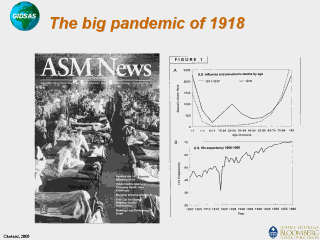| front |1 |2 |3 |4 |5 |6 |7 |8 |9 |10 |11 |12 |13 |14 |15 |16 |17 |18 |19 |20 |21 |22 |23 |24 |25 |26 |27 |28 |29 |30 |31 |32 |33 |34 |35 |36 |37 |38 |39 |40 |41 |42 |43 |44 |45 |46 |47 |48 |49 |review |
 |
Describe
epidemics in 1917 and 1918 - called “Spanish” flu but more likely US flu.
Initial epidemic in 1917, different susceptible population. No virology at
that time so no virus isolated. Attempts to recover virus from frozen tissue
(Arctic or Norway) or from archived formalin-fixed tissue from 1918.
Information beginning to emerge - Taubenberger - still don’t know why virus
was virulent. Studies on archived sera and information on main proteins of
1918 virus indicate - avian-pigs-acquired ability to cause disease in humans
and human to human spread. Globe and Mail Feb 22, 2003 Officials on alert for deadly bird flu. Emphasize: 33 year old man dead (young), first case since 1997 (is virus returning), virus very virulent (less susceptible to TNFa), can it acquire ability to transfer from person to person. |